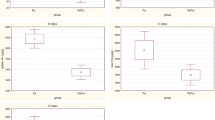Abstract
To check the hypothesis that adequate dietary iron supplementation reduces cadmium retention and cadmium-induced anaemia during fast growth, three different dietary iron concentrations (6 mg/kg=iron-deficient; 55 mg/kg=marginal iron supply; 180 mg/kg=luxurious iron supply) were offered to growing rats. Four groups of rats at different age (44 days≊150±6 g, 49 days≊180±3 g, 57 days≊220±4 g, and 84 days≊295±9 g) received a diet with 55 mg Fe/kg which is a marginal iron-supply during growth. Six animals in each age group were exposed to 10 mg Cd/l as CdCl2 in the drinking water for 1 week; six animals in each age group received no cadmium. In the youngest and oldest groups additional 6 animals were exposed to the same cadmium dose but received an iron-deficient (6 mg Fe/kg) and an iron-adequate diet (180 mg Fe/kg) together with corresponding controls. The state of iron repletion was monitored by the tissue iron content in liver, kidney, and duodenum as well as by the concentrations of haemoglobin, plasma iron and plasma transferrin. The youngest animals showed the highest percent weight increases. Cadmium administration influenced neither growth rates nor food and water intake. At a dietary iron content of 55 mg/kg, iron repletion was negatively correlated to growth while the cadmium content in liver and kidney showed a positive correlation. At fast growth, a dietary iron content of 6 mg/kg lead to iron-deficiency anaemia and high cadmium retention. At all dietary iron concentrations, cadmium retention as well as the cadmium-related reduction in haemoglobin concentration was significantly higher at fast growth. Adequate dietary iron supplementation reduced cadmium retention and cadmium-induced anaemia significantly. Thus, the delicate balance between iron supply and the increased iron demand during growth can be disturbed within one week by a daily cadmium intake as low as 0.7–1.3 mg Cd/kg body weight.
Similar content being viewed by others
References
Beutler E (1957) Iron enzymes in iron deficiency. I. Cytochrome C. Am J Med Sci 234:517–527
Conrad ME, Barton JC (1978) Factors affecting the absorption and excretion of lead in the rat. Gastroenterology 74:731–740
Cousins RJ, Funk AE, Brady FO (1973) Cadmium toxicity in growing swine. J Nutr 103:964–972
Dinsdale D, Webb M, Holt D (1986) Intestinal uptake and retention of copper in the suckling rat, rattus rattus. III. Effect of closure. Comp Biochem Physiol 84:311–314
Flanagan PR, McLellan JS, Haist J, Cherian MG, Chamberlain MJ, Valberg LS (1978) Increased dietary cadmium absorption in mice and human subjects with iron deficiency. Gastroenterology 74:841–846
Foulkes EC, Bergman DC (1993) Inorganic mercury absorption in mature and immature rat jejunum: transzellular and interzellular pathways in vivo and in everted sacs. Toxicol Appl Pharmacol 120:89–95
Friberg L, Kjellström T, Nordberg GF (1986) Cadmium. In Handbook on the toxicology of metals (Vol. II); Friberg L, Nordberg GF, Vouk VB (eds), Elsevier, Amsterdam, 130–184
Heinrich HC, Bartels H, Götze C, Schäfer KH (1969) Normalbereich der intestinalen Eisenresorption bei Neugeborenen und Säuglingen. Klin Wschr 47:984–991
Henke G, Sachs AW, Bohn G (1970) Cadmium-Bestimmungen in Leber und Nieren von Kindern und Jugendlichen durch Neutronenaktivierungsanalyse. Arch Toxicol 26:8–16
Henning SJ (1986) Development of the gastrointestinal tract. Proc Nutr. Soc 45:39–44
Hillman RS (1990) Hematopoetic agents: growth factors, minerals, and vitamins. In Goodman Gilman A, W Rall, AS Nies, P Taylor (eds): The pharmacological basis of therapeutics, 8th Ed., Macmillan Publ Comp., New York, Ch. 54
Leon L, Johnson DR (1985) Role of iron in jejunal uptake of cadmium in the newborn rat. J Toxicol Environ Health 15:687–696
Mancini G, Carbonara AO, Heremans JF (1965) Immunochemical quantiation of antigens by single radial immunodiffusion. Immunochemistry: 235–254
Murata I, Hirono T, Saeki Y, Nakagawa S (1970) Cadmium enteropathy, renal osteomalacia (“itai itai” disease in Japan). Bull Soc Int Chir 31:1–9
Nogawa K, Honda R, Yamada Y, Kido T, Tsuritani I, Ishizaki M (1984) Iron concentration in liver and kidney of cadmium exposed human subjects. Toxicol Lett 321:209–212
Sachs L (1984) Angewandte Statistik, 6. Auflage, Springer-Verlag, Berlin
Schäfer SG, Forth W (1984) Effect of acute and subchronic exposure to cadmium on the retention of iron in rats. J Nutr 114:1989–1996
Schäfer SG, Elsenhans B (1985) Iron retention and distribution in cadmium-induced iron-deficiency. Ecotoxicol Environ Safety 10:128–141
Schümann K, Elsenhans B, Hunder G, Strugala G, Forth W (1989) Increase of the intestinal iron absorption in growing rats and mice after 8 days of iron deficient feeding. Z Versuchstierkd 32:261–267
Stoeppler M (1984). Cadmium. In: Metalle in der Umwelt, E. Merian (ed.), Verlag Chemie, Weinheim, Deerfield Beach, Basel, pp 375–408
Sternowsky H, Wessolowski R (1985) Lead and cadmium in breast milk. Arch Toxicol 57:41–45
Waalkes MP, Klaassen CD (1984) Effect of age on cadmium induced metallothionein synthesis in various organs of the rat. Toxicol Appl Pharmacol 74:314–320
Author information
Authors and Affiliations
Additional information
Part of the data was presented in “Bioavailability 93,” Proceedings of “Bioavailability 93,” Vol. II, U. Schlemmer (ed.), Berichte der Bundesforschungsanstalt für Ernährung, Karlsruhe, 1994
Rights and permissions
About this article
Cite this article
Schümann, K., Friebel, P., Schmolke, G. et al. State of iron repletion and cadmium tissue accumulation as a function of growth in young rats after oral cadmium exposure. Arch. Environ. Contam. Toxicol. 31, 483–487 (1996). https://doi.org/10.1007/BF00212431
Received:
Revised:
Issue Date:
DOI: https://doi.org/10.1007/BF00212431



